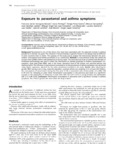Mostrar o rexistro simple do ítem
Exposure to paracetamol and asthma symptoms
| dc.contributor.author | González-Barcala, Francisco-Javier | |
| dc.contributor.author | Pértega-Díaz, Sonia | |
| dc.contributor.author | Pérez-Castro, Teresa-Rosalía | |
| dc.contributor.author | Sampedro-Campos, Manuel | |
| dc.contributor.author | Sánchez-Lastres, Juan Manuel | |
| dc.contributor.author | San-José-González, Miguel-Ángel | |
| dc.contributor.author | Bamonde-Rodríguez, Luis | |
| dc.contributor.author | Garnelo-Suárez, Luciano | |
| dc.contributor.author | Valdés Cuadrado, Luis | |
| dc.contributor.author | Carreira, J.M. | |
| dc.contributor.author | Moure, J.D. | |
| dc.contributor.author | López-Silvarrey-Varela, Ángel | |
| dc.date.accessioned | 2022-06-16T10:27:53Z | |
| dc.date.available | 2022-06-16T10:27:53Z | |
| dc.date.issued | 2012-05-29 | |
| dc.identifier.citation | Gonzalez-Barcala FJ, Pertega S, Perez Castro T, Sampedro M, Sanchez Lastres J, San Jose Gonzalez MA, Bamonde L, Garnelo L, Valdes L, Carreira JM, Moure J, Lopez Silvarrey A. Exposure to paracetamol and asthma symptoms. Eur J Public Health. 2013 Aug;23(4):706-10. doi: 10.1093/eurpub/cks061. Epub 2012 May 29. PMID: 22645237. | es_ES |
| dc.identifier.issn | 1101-1262 | |
| dc.identifier.uri | http://hdl.handle.net/2183/30943 | |
| dc.description | Multicenter study | es_ES |
| dc.description.abstract | [Abstract] Background: Paracetamol is one of the factors that have been associated with the observed increase in asthma prevalence in the last few years. The influence of environmental or genetic factors in this disease may be different in some countries than in others. The purpose of this study was to analyse the relationship between the paracetamol consumption and asthma prevalence in our community. Methods: A cross-sectional study was conducted on more than 20,000 children and adolescents in Galicia, Spain. The International Study of Asthma and Allergies in Childhood methodology was used to collect the information on asthma symptoms in children, paracetamol consumption, body mass index (BMI), pets in the home, education level of the mother and parental asthma and smoking habits. The influence of paracetamol consumption on the prevalence of asthma symptoms was calculated using logistic regression, adjusted for the other parameters included in the study. Results: After adjusting for gender, BMI, having a cat or dog, maternal education, parental asthma and smoking, in 6- to 7-year-old children, the consumption of paracetamol during the first year of life is associated with asthma [odds ratio (OR) 2.04 (1.79-2.31) for wheezing at some time]. Paracetamol consumption in the previous year leads to a significant increase in the probability of wheezing at some time [OR 3.32 (2.51-4.41)] in young children and adolescents [OR 2.12 (1.68-2.67)]. Conclusions: Paracetamol consumption is associated with a significant increase in asthma symptoms. The effect is greater the more often the drug is taken. | es_ES |
| dc.language.iso | eng | es_ES |
| dc.publisher | Oxford Academic | es_ES |
| dc.relation.uri | https://doi.org/10.1093/eurpub/cks061 | es_ES |
| dc.rights | Atribución-NoComercial 3.0 España | es_ES |
| dc.rights.uri | http://creativecommons.org/licenses/by-nc/3.0/es/ | * |
| dc.subject | Acetaminophen | es_ES |
| dc.subject | Analgesics, Non-narcotic | es_ES |
| dc.subject | Asthma | es_ES |
| dc.title | Exposure to paracetamol and asthma symptoms | es_ES |
| dc.type | info:eu-repo/semantics/article | es_ES |
| dc.rights.access | info:eu-repo/semantics/openAccess | es_ES |
| UDC.journalTitle | European Journal of Public Health | es_ES |
| UDC.volume | 23 | es_ES |
| UDC.issue | 4 | es_ES |
| UDC.startPage | 706 | es_ES |
| UDC.endPage | 710 | es_ES |
Ficheiros no ítem
Este ítem aparece na(s) seguinte(s) colección(s)
-
INIBIC-ECB - Artigos [50]






